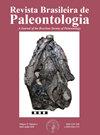Fósseis em uma frente de extração de mármore? Análises tafonômica e paleoicnológica de mamíferos de grande porte do Quaternário do Espírito Santo, Brasil
IF 0.6
4区 地球科学
Q4 PALEONTOLOGY
引用次数: 0
Abstract
The occurrence of fossil mammals in the State of Espirito Santo is rare, with only two records, both reported to sediments localized within marble quarries in the district of Itaoca, in the Municipality of Cachoeiro de Itapemirim. The first record dates from 1978, when fossils of Eremotherium and gomphotheres were collected together with other vertebrate fossils and posteriorly described. The second dates from 1983, with the description of fossils of Eremotherium in an abstract. Part of this latter finding is housed at the Federal University of Espirito Santo (UFES) and represents the only fossil mammals from the State that are currently available for study. It comprises15 specimens, including cranial and post-cranial material. From these, eight can be referred to Eremotherium, one to Toxodontinae, one to Notiomastodon, and the others to large-bodied mammals. Fossils of Eremotherium and of indeterminate mammals are compatible with the presence of one giant ground sloth individual. Taphonomic and paleoichnological analyses of this supposed individual show that after death carnivores scavenged the carcass and that the bones were exposed to weathering for a relatively short time until they were transported by a hydraulic flow to a crevice, thus explaining the unusual finding of fossils in this particular outcrop.大理石提取正面的化石?巴西圣埃斯皮里托第四纪大型哺乳动物的地质和古生物学分析
在圣埃斯皮里图州发现哺乳动物化石是罕见的,只有两个记录,都是在卡乔埃罗市伊塔佩米林市伊塔奥卡区大理石采石场的沉积物中发现的。最早的记录是在1978年,当时人们收集了石首兽和槌形兽的化石,并对它们与其他脊椎动物化石进行了描述。第二份是1983年的,在摘要中描述了Eremotherium的化石。后一项发现的一部分保存在圣埃斯皮里图联邦大学(ues),是该州目前唯一可用于研究的哺乳动物化石。它包括15个标本,包括颅和颅后材料。其中,有8种属于热齿兽,1种属于弓齿兽,1种属于野乳齿兽,其他的属于大型哺乳动物。土懒的化石和不确定的哺乳动物的化石与一只巨型地懒个体的存在是相容的。对这具疑似个体的地形学和古人类技术分析表明,在这具尸体死后,食肉动物会把它吃掉,骨头在相对较短的时间内暴露在风化环境中,直到它们被水力水流输送到一个裂缝中,从而解释了在这一特殊露头中发现化石的不寻常之处。
本文章由计算机程序翻译,如有差异,请以英文原文为准。
求助全文
约1分钟内获得全文
求助全文
来源期刊

Revista Brasileira De Paleontologia
PALEONTOLOGY-
CiteScore
1.60
自引率
14.30%
发文量
25
审稿时长
>12 weeks
期刊介绍:
It publishes original contributions on all aspects of Paleontology. Papers are written in English, Spanish, or Portuguese and are reviewed by international experts.
 求助内容:
求助内容: 应助结果提醒方式:
应助结果提醒方式:


